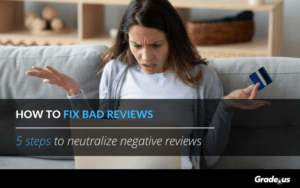Hug Your Haters by Jay Baer will change the way your businesses approaches customer service.
Baer has written one of the most important and useful books on customer service for our current age.
“Important” because Baer presents counter-intuitive insights that will transform the way brands and business owners think about the role of customer service in their success and their survival.
“Useful” because he distills these insights into axioms that brands and business owners can enact today to turn customer service into a bigger driver of business success than product quality or marketing dollars.
In this post, I’ll give you a quick take on the insights and axioms that make this book a must-read for anyone responsible for a brand or business.
Offstage Versus Onstage Channels

If our customer service is below par, the public-facing nature of online review sites can be terrifying. Most companies still haven’t mastered phone and email support. Social media, online forums and online review sites add new challenges to providing efficient and expedient customer service.
Addressing the differences between these channels, Baer distinguishes two types of haters:
Offstage haters and Onstage haters.
Offstage haters are consumers that prefer to communicate via private channels like email or the phone, while onstage haters prefer more public channels like social media, online review sites and online forums.
The two types differ in both demographics and intent when reaching out to brands.
Offstage haters are “slightly older, less mobile and social media savvy, and they complain somewhat less frequently on an annual basis.” (Baer 35)
Onstage haters skew younger and are more comfortable using technology, like social media. It also makes sense that onstage haters complain more, not because they’re more irritable individuals, but because the channels they frequently use are easier to use on the fly (via mobile) and the fast paced nature of social media has become appropriate for more superficial complaints.
With regards to a hater’s intent, Baer explains it clearly:
“Offstage haters want an answer. In many cases, onstage haters want an audience.”
(Baer 45)
So if negative reviews come from a vocal group of onstage haters who want an audience, how can we effectively handle their objections in the eyes of the public without damaging our reputation with the rest of the lurking audience? Baer provides some important research-backed reasons for responding appropriately.
Why Respond to Onstage Haters on Review Sites
“Answer every complaint, in every channel, every time.”
(Baer 10)
Based on Baer’s research, there are four reasons to live by this strategy:
- Turning Bad News Into Good News
- Creating Customer Advocacy
- Gathering Insights and Intelligence
- Differentiate From Your Competition
Turning Bad News Into Good News
Responding to your haters, provides the opportunity to fix the negative experience that your customer had with your business. Baer points out that most businesses are focused on customer acquisition rather than customer retention. When we recover a negative customer experience, we’re much more likely to retain that customer.
Creating Customer Advocacy
A bit counterintuitive, but based on the book’s research (emphasis is mine), “answering customer complaints increases customer advocacy, regardless of complaint channel or type.” (Baer 21) In fact, rectifying a customer experience results in the customer actually helping to promote the company (which results in the customer acquistion most businesses are already focusing on anyway). It can be pretty useful to have ex-haters shouting your praises from the rooftops.
Gathering Insights and Intelligence
While you can glean useful information from online reviews, I want to make a clarification that Baer did not address in this section of his book. Actively using a strategy to get more online reviews should be a separate endeavor from soliciting feedback. When we want feedback on our company, we usually have specific questions we’re hoping our customers will answer. If the feedback is not solicited, it’s important to that customer. They’re trying to get your help in solving a problem. Asking them to answer other questions unrelated to their problem makes the issue about the company and not the customer.
Online reviews serve to educate other potential consumers on their personal experience, they’re about what the consumer want to communicate to others, not what we want them to highlight (positive and negative).
Differentiate From Your Competition
Across different communication channels, customers have different expectations. When we email a company or call them, we expect a response, preferably within 24 hours. Our expectations of a response from social media, forums and online review site channels are much lower.
“Since the pace and cadence of interaction on review sites are not as quick as they are on Facebook and Twitter, haters’ expectations for response times on these sites are not as aggressive, and their overall satisfaction is higher.” (Baer 57)
When we browse any online review site, we’ll see that business owners rarely respond to reviews. Most of us don’t know how to respond in these situations, which cripples our ability to provide quality customer service. Companies that do respond to online reviews will stand out from our competitors.
Since reviewers don’t expect a response from us, let alone in a reasonable time frame, any correspondence will show the hater (and all of the watching lurkers) that there’s a real person behind the company who cares. According to the research, “the greatest increase in customer advocacy comes when you respond to haters who do not expect a response.” (Baer 58)
How To Respond to Onstage Haters on Review Sites
But now comes the tricky part. Review sites actually receive the majority of negative feedback and onstage hater complaints compared to any other channel.
“The best possible way to engage with customers on any rating site is to answer every review. If it’s positive, say thank you. If it’s negative, apologize. If it’s neutral, use the feedback to make your operations better.”
(Baer 81)
That’s pretty straightforward but useful advice.
Baer formulated an appropriate acronym for responding to onstage haters: F-E-A-R-S
- Find All Mentions
- Display Empathy
- Answer Publicly
- Reply Only Twice
- Switch Channels
Find All Mentions
There are hundreds of major and niche reviews sites today, which can be difficult to track. We typically know which sites we’re focused our review strategy (Google, Yelp, industry specific sites). But consumers may also be leaving reviews on sites where we didn’t even know we had a listing. That’s why any company that’s adding review site customer service should scan their business to see how they’re performing currently on review sites. Find all the mentions, and be prepared when a new review requires a response.
Display Empathy
Automation is all the rage, it saves our companies time and money. It’s tempting to have a series of scripts to use when responding to negative reviews, but that’s the last thing those customers desire.
When we’re angry, (whether we’re in the right or the wrong) we want someone to at least commiserate with us. Automated or boilerplate replies are cold and lack empathy. Even if you can’t provide the answer that the hater wants, actively listening and proving that there’s a person behind the reply goes a long way.
Answer Publicly
Baer points out the reason to answer online reviews (both positive and negative) is they provide us with an opportunity to show our customer service transparently. Answering reviews publicly soothes the onstage hater’s need for an audience. But selfishly, it’s just as much about all of those other lurkers who are watching to see how we respond (or if we respond at all). By submitting a public reply, we’re killing two birds with one stone: satisfy the hater and impress the lurkers.
Reply Only Twice
Another of Baer’s axioms, replying only twice, prevents us from getting into a heated debate with the hater, which is sometimes the only thing they desire. It’s essential that we keep our composure, and not respond emotionally, even if the negative review incites our anger.
When we provide a reasonable solution, as well as the opportunity to take the conversation private, we’re showing everyone a genuine attempt to solve the problem without compromising our reputation.
Note:
Baer does in fact have a vocally abrasive third group of haters that he refers to as the ‘crazies’. “There are at least three different methods of dealing with the unhinged haters: ignoring them, researching them, and hugging them.” (Baer 49) Chances are, we won’t be able to satisfy them, but when we treat them with respect and they continue to respond irrationally in public, your silent audience will appreciate your even-keel demeanor.Switch Channels
Sometimes, in order to solve a customer’s problem, we need more information in order to provide a more comprehensive response. Abiding by the reply only twice maxim, we can request the hater to contact us on a private channel to remedy the situation. Online review site responses are not the appropriate place to solve more complicated issues.
Takeaways
Many companies do not allocate enough resources to their customer support efforts. Customer service requires training, manpower, strategy, and a key understanding of core company values.
Baer’s book is a must read for any company that wants to thrive. His relatable case studies and pioneering research provide a trustworthy framework for an actionable “customer service as marketing” plan.
Many of Baer’s insights are counterintuitive, violating our preconceived notions of how customer service should work. But his research and conclusions are compelling–and hard to refute.
Remember, if we publicly respond to every online review with empathy, in a timely manner, or take it private, we exceed the expectations of our haters nearly 100% of the time. Every company has haters, and haters are most vocal on review sites, so it’s essential that our businesses are prepared. It’s a matter of when, not if, haters of our own will rear their lovely, huggable heads online.
Get Your Own Copy of Jay Baer’s Book Hug Your Haters on Amazon or Barnes And Noble, Visit Jay Baer’s Digital Marketing Blog Convince and Convert, and Follow Baer on Twitter.
Reference: Baer, Jay. Hug Your Haters: How to Embrace Complaints and Keep Your Customers. New York: Penguin Random House, 2016.
About the Author
Garrett Sussman
Garrett is the Head of Marketing at Grade.us, an online review management and marketing platform. When he's not crafting content, he's scouting the perfect ice coffee, devouring the newest graphic novels, and concocting a new recipe in the kitchen.










